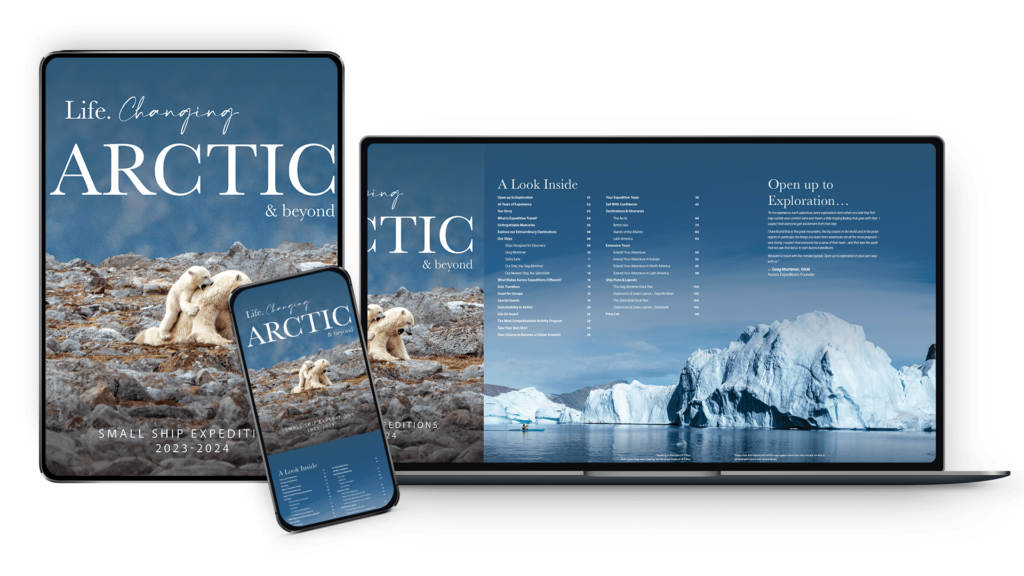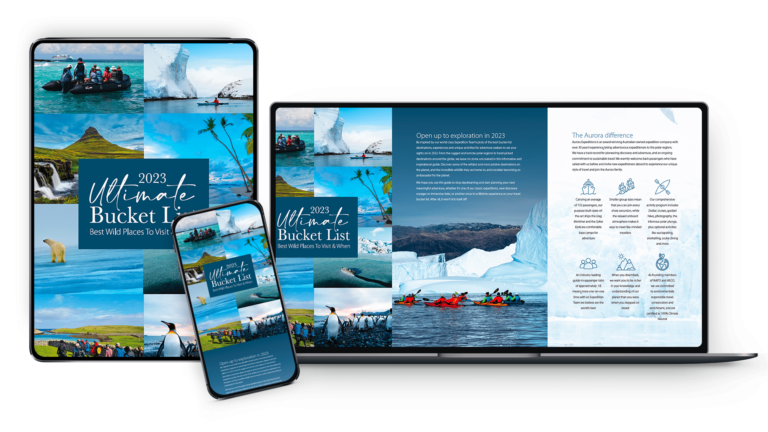From the rainforests of Costa Rica to the history-rich coastlines of Scotland, Aurora’s expert Expedition Team is skilled at navigating to hidden gems to share with passengers onboard small ship expeditions to our carefully selected global destinations.
As part of Aurora’s Discovery Voyage series, these voyages include a mix of off-the-beaten-track locations along with well known and accessible sights. Our purpose-built expedition ships and Zodiacs easily access coastal villages, bays and islands, while on shore we use land-based transportation including our own two feet to find local trailheads, natural monuments and historical sights.
Dive into our favourite unique experiences on our Global Experiences Bucket List that you won’t want to miss.
2023 Bucket List e-book
Zodiac to Fingal’s Cave on the Isle of Staffa, Scotland
Located in the Inner Hebrides of northern Scotland is the Isle of Staffa. Formed through volcanic activity, Staffa is known for its caves and basalt columns, similar to those found on the Giant’s Causeway in Northern Ireland. Explore Fingal’s Cave by Zodiac and listen to the melodious sound of waves crashing against towering basalt pillars, which reportedly inspired Mendelssohn’s Hebridean Overture.
Search for sloths and monkeys in Costa Rica
Boasting over 100 species of mammals, 184 species of birds and an impressive variety flora, Manuel Antonio National Park understandably attracts wildlife enthusiasts from all over the world. Costa Rica’s star attractions – two and three toed sloths, as well as white-faced monkeys, toucans, agoutis, armadillos and coatis, are just some of the exciting animals that you may encounter within the park.
Dive and Snorkel in Coiba Island, Panama
Coiba Island, a National Park and a UNESCO World Heritage site, is located off the southwest coast of Panama. The national park includes the main island of Coiba and 38 smaller islands in the surrounding marine areas within the Gulf of Chiriquí. Visit the area of Granito de Oro islet, a unique place that allows snorkellers to encounter a diversity and volume of marine life that is usually reserved for scuba divers. This is one of the world’s most sought-after diving destinations. The park is home to many marine species, including dolphins, humpback whales, sperm whales, orcas, whale sharks, manta rays, sea turtles, and white-tip reef sharks. 760 species of fish have been recorded here, including Barracudas, Snappers, Amberjack, and Marlin.
Guanaco spotting and trekking in Patagonia
Immerse yourself in the treasures of Chilean Patagonia. Discover the dramatic alpine scenery and fascinating wildlife of the Torres del Paine National Park. Ascend through the Ascencio Valley along the renowned W Trail or take in the stunning views on the lesser-known Lazo-Weber trail. Keep your eyes peeled for Andean condors, rheas, flamingos and guanacos. Closely related to the llama, guanacos are one of the largest terrestrial mammals in South America. While they are usually found at very high altitudes, in Patagonia they are found lower down, where food and grazing is possible.
Hike the royal estate Balmoral and spot wildlife in Cairngorms National Park, Scotland
Listed by National Geographic as one of the top 50 of the World’s Last Great Places, Cairngorms National Park is graced with lush forests, serene woodlands, charming villages, and a rich history and heritage. Hike on the beautiful Balmoral Estate, home to Balmoral Castle – the royal family’s summer residence, and through ancient woodlands past a series of cairns and monuments erected by the Royal Family over the years. Spot red deer, golden eagles and even the rare capercaillie found in Glen Freshie.
Daytime crossing of the Panama Canal
Each year, over a million people visit the canal to witness this engineering marvel at work. Starting in the Pacific Ocean, you will be able to admire the Bay of Panama and Panama City’s splendid skyline before passing under the ‘Bridge of the Americas’. The ship will then transit through the Miraflores Locks, where it will be lifted 16 metres (52 foot) in two distinct steps, followed by the Pedro Miguel Locks, where the vessel is lifted 9 metres (29 foot) in one step. Travel through the Gaillard Cut, which was carved through the Continental Divide, this section of the canal is full of history and geological value. In the Atlantic sectors, at Gatun Locks, the vessel will be lowered a total of 26 metres (85 foot) in three distinct chambers.
The complete crossing from the Pacific to the Atlantic Ocean takes approximately 10 hours, a journey that once took almost two weeks to complete, when vessels were forced to sail around the notoriously rough seas around Cape Horn at the bottom of South America to reach the Pacific coast. Experience it for yourself on the Costa Rica & Panama Canal voyage.
Go global and start ticking off some of these Bucket List experiences.
View our new season brochure to inspire your next adventure, or contact our expert team.

Arctic & Beyond 2024 Season Brochure
Explore our Arctic & Global 2024 season, full of life changing adventures across the wildest and most remote destinations around the globe. Choose from 15 departures exploring the Arctic and 3 voyages to our hand-picked Global destinations.
Dive into our comprehensive 112-page brochure and find your next life-changing adventure.
Patagonia & Chilean Fjords
Expedition
Welcome to Aurora’s Patagonia and Chilean Fjords expedition. Sail the legendary Beagle Channel and marvel at the snow-covered peaks of rugged Patagonia. Zodiac-cruise through fjords flanked by glaciers and watch as...
15 Days
From USD $11,836.00/pp
Wild Scotland
Discovery
Discover the wild isles of Scotland, from the windswept Hebrides, inhabited for over 8,000 years, to the verdant Orkney Islands, where ancient Neolithic and Viking sites conjure images of civilisations...
12 Days
From USD $11,980.75/pp
Patagonia Discovery Trek (Argentina Return)
Trekking
Welcome to our Patagonia Discovery Trek expedition. Discover the vast Patagonian wilderness on this unique guided walking trip, taking in two of Patagonia’s most iconic national parks and the famed Perito...
10 Days
From USD $5,545.00/pp
Patagonia Discovery Trek (Chile to Argentina)
Trekking
10 Days
From USD $5,545.00/pp
Costa Rica & Panama Canal
Discovery
Welcome to Aurora Expeditions’ Costa Rica and the Panama Canal voyage. Immerse yourself in the remarkable coastlines of Costa Rica and Panama. Costa Rica is one of the most biodiverse regions...
12 Days
From USD $11,215.75/pp


